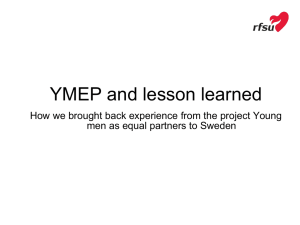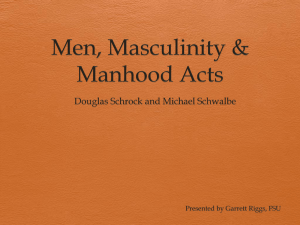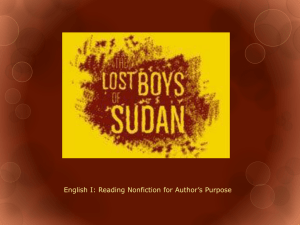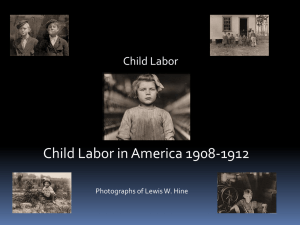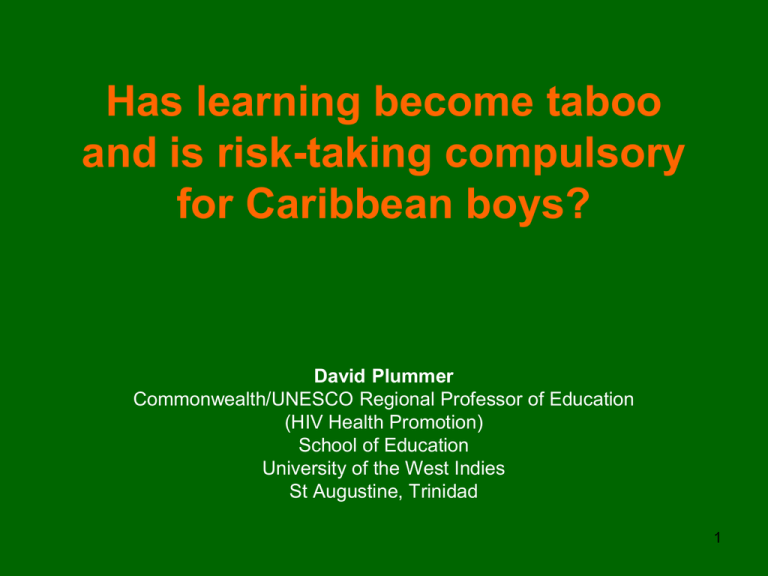
Has learning become taboo
and is risk-taking compulsory
for Caribbean boys?
David Plummer
Commonwealth/UNESCO Regional Professor of Education
(HIV Health Promotion)
School of Education
University of the West Indies
St Augustine, Trinidad
1
Policing masculinity
2
“As the boy approaches pre-pubescent years… the peer group
begins to exercise its magnetic pull.”
(Chevannes 1999: 29)
“The peer group virtually replaces mother and father as the
controlling agents or, if not entirely a substitute, a
countervailing force.”
(Chevannes 1999: 30)
“The worst and most individualistic and predatory aspects of
the street became the norm for youngsters who found
validation for their behaviour in their peers and in the larger
environment.”
(Bailey, Branche, McGarrity & Stuart 1998: 82)
“In time, some of these groups become fundamental identity –
bearing groups that not only impose themselves on the
behaviour of the young men but separate them competitively
and conflictually from other similar groups of young men.”
(Bailey, Branche, McGarrity & Stuart 1998: 59)
“… these activities demonstrated “power” to parents, women,
teachers and friends, who were proud to see that a young man
was not a buller, a sissy or a coward.”
(Crichlow 2004: 201)
“An adolescent boy’s friends exact an affinity and a loyalty as
sacred as the bond of kinship as strong as the sentiment of
religion. They socialise one another, the older members of the
group acting as the transmitters of what passes as knowledge,
invent new values and meanings.”
(Chevannes 1999: 30)
4
Aspiring to be bad:
peer group obligations and
the rise of hard masculinity
5
“… younger teenaged boys had embraced, in the most
uncompromising way, the [prevailing] male gender ideology.”
(Bailey, Branche, McGarrity & Stuart 1998: 82)
In an attempt to temporarily secure my masculinity or hypermasculinity and hegemonic heterosexuality, I participated in
events such as stealing… breaking bottles with slingshots or
stones on the street, engaging in physical fights, and “hanging
on the block” with boys until late at night.”
(Crichlow 2004: 200)
“The so-called inner-city don is a role model not only because
of his ability to command and dispense largesse, but also
because he is a living source of power the power over life and
death, the ultimate man… Among the youth, a common word
for penis was rifle.”
(Chevannes 1999: 29)
6
Sexual prowess
and HIV risk
7
“By the age of 10… boys began to realise that toughness,
physical strength and sexual dominance, all features of
traditional masculinity, were expected of them.”
(Bailey, Branche, McGarrity & Stuart 1998: 82)
“Sex then was very much in the environment of the young
boys and girls… they did pick up a great deal of information
from observing their environment and from listening to
“people”, particularly the age group just older than
themselves.”
(Bailey, Branche, McGarrity & Stuart 1998: 66)
8
“Boys are expected to obtain virtually all their sexual
preparation on the street and secondarily from school.”
(Brown & Chevannes 1998: 23)
“Manhood is demonstrated by sexual prowess… it is usually
measured… by the number of female sexual partners.”
(Brown & Chevannes 1998: 23)
9
“For males, multiple partnerships could become also a matter
of status… (p 65). The term ‘one burner’ applied to a faithful
male in some Jamaican communities was a phrase of
derision.”
(Bailey, Branche, McGarrity & Stuart 1998: 66)
“Someone who did not have as many women as they did was
“sick”, “suspected as a buller” or not “the average young
black male”.”
(Crichlow 2004: 206)
10
Masculine taboos:
enforcing ‘no-go’ zones
11
“Boys greet each other with clenched fists and backslaps, and
often use other forms of aggression to express their feelings.”
(Brown & Chevannes 1998: 30)
“Our fights usually indicated an “overt disdain for anything
that might appear soft or wet – more a taboo on tenderness
than a celebration of violence”
(Morgan quoted in Crichlow 2004: 200)
“The culture demanded physical responses from boys and
made toughness the hallmark of the real male. Young boys
knew that if they performed outside the expected, traditional
roles they would be ridiculed and labelled ‘sissy’ by boys and
girls.”
(Bailey, Branche & Henry-Lee 2002: 8)
12
Is boys’ education a casualty
of the rise in hard masculinity?
13
“School is girl stuff!” This declaration by an eight-year old inner-city
boy… reveals the association built up in the minds of many boys.”
(Chevannes 1999: 26)
“Many young men in Trinidad argue that academic subjects such as
mathematics, physics and English are for bullers and women, while
trades are for men”
(Crichlow 2004: 206)
“There is evidence that boys actually actively assert their maleness by
resisting school. This is particularly true with respect to certain
subjects that are seen as “feminine”. Male-child subculture therefore
exerts considerable peer pressure on boys to be disruptive in school
and to underrate certain subjects.”
(Figueroa 2004: 152)
“The homophobic fears expressed by staff and the resulting censure
of attitudes and behaviours which were felt to be “effeminate”,
“girlish”, “sissy like” and “nerdish” reinforce a masculine gender
identity which rejects many aspects of schooling as all of the above.”
(Parry 2004: 179)
14
“Are males being marginalised? Certainly not if the main factor being
considered is power.”
(Chevannes 1999: 33)
15
Table 1: The way forward
Celebrate girls’ educational successes as important Caribbean accomplishments
Take a more strategic approach to promoting boys’ achievements
De-link girls’ successes from boys’ difficulties
Recognise that contemporary dominant masculinities are problematic
Resist hard, narrow, polarised masculinity
Counterbalance hard, physical, narrow masculinities with well-rounded male
role models
Embrace diverse masculinities and alternative male role models
Re-associate masculinity with education and academic prowess
Engage more fully with peer group dynamics
Confront the taboos that cause boys to flee from educational pursuits and
retreat to hard, physical masculinity
Reject homophobic and misogynist prejudices
Support research into masculinities, masculine taboos and peer group dynamics
Table 2: Social Embedding
•
•
•
•
Gender roles
Peer group dynamics
Taboo and stigma
Socioeconomics
17
Thank you
Acknowledgements
I would like to thank the Commonwealth, UNESCO and the
University of the West Indies for supporting this research
18


